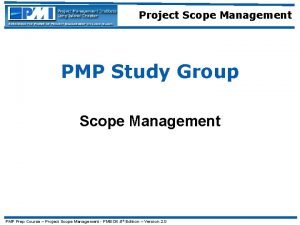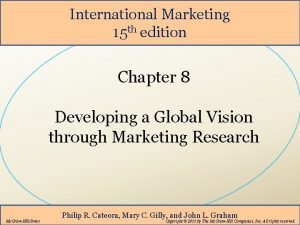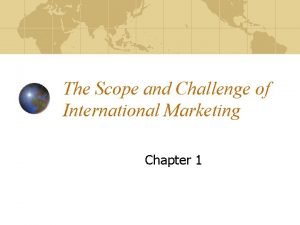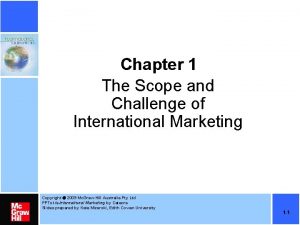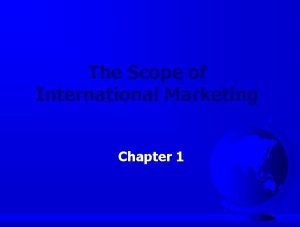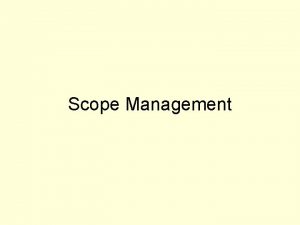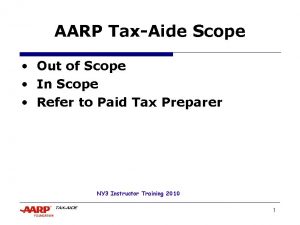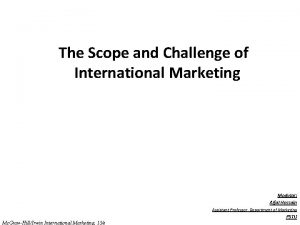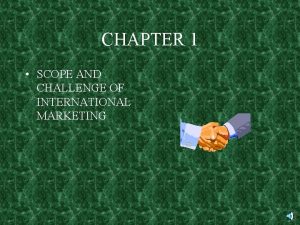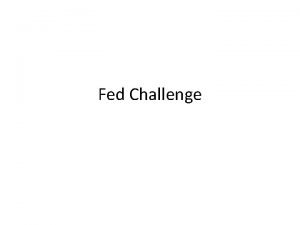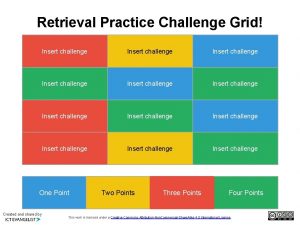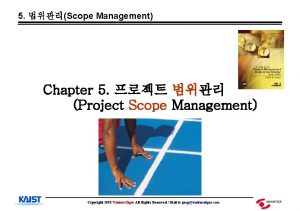Chapter 1 The Scope and Challenge of International





















- Slides: 21


Chapter 1 The Scope and Challenge of International Marketing Mc. Graw-Hill/Irwin © 2005 The Mc. Graw-Hill Companies, Inc. All rights reserved

Chapter Learning Objectives 1. The changing face of U. S. business 2. The scope of the international marketing task 3. The increasing importance of global awareness 4. The progression of becoming a global marketer 5. The importance of the self-reference criterion (SRC) in international marketing

Preface “Never before in American history have U. S. businesses, large and small, been so deeply involved in and affected by international business. A global economic boom, unprecedented in modern economic history, has been under way as the drive for efficiency, productivity, and open, unregulated markets sweeps the world. Powerful economic, technological, industrial, political, and demographic forces are converging to build the foundation of a new global economic order on which the structure of a one-world economic and market system will be built” (Cateora and Graham)

Global Perspective: Recent Events Information technology boom of the late 1990 s The high-tech bust of 2001 Enron and World. Com scandals September 11 th attacks on the World Trade Center and Pentagon Wars in Afghanistan and Iraq

Global Perspective: Recent Events International conflict among China, Taiwan, and the United States 2003 SARS outbreak in Asia Global terrorism, e. g. , Indonesia, Israel, India, and Morocco Transcending these events, international commerce continued

Global Business Trends 1. The rapid growth of the 2. World Trade Organization 3. and regional free trade 4. areas, e. g. , NAFTA and the 5. European Union 2. General acceptance of the free market system among developing countries in Latin America, Asia, and Eastern Europe 3. Impact of the Internet and other global media on the dissolution of national borders, and 4. Managing global environmental resources

Internationalization of U. S. Business Increasing globalization of markets Many U. S. companies are now foreign controlled: Carnation (Swiss), Daimler-Chrysler (German) Firms face competition on all fronts U. S. firms seeking foreign markets to increase profits



International Marketing: A Definition International marketing is defined as the performance of business activities designed to plan, price, promote, and direct the flow of a company’s goods and services to consumers or users in more than one nation for a profit Marketing concepts, processes, and principles are universally applicable all over the world

The International Marketing Task Foreign Environment (Uncontrollables) 1. Competition 7. Structure of Distribution Domestic environment Environmental (Uncontrollables) uncontrollables country market A 1. Competition (Controllables) 2. Technology Price Product 5. Political- Target Environmenta 7 Market l 6. Geography and Legal uncontrollabl Promotion. Place or 2 Infrastructure es Distribution. Technology country 4. market B Cultur Environment 3. Economy e al 5. Political 3. Economy uncontrollab Legal les country 4. market C Culture

Environmental Adaptation Needed Differences are in the uncontrollable environment of international marketing Firms must adapt to uncontrollable environment of international marketing by adjusting the marketing mix (product, price, promotion, and distribution) Continuum Adaptation (of Marketing Mix) Standardization (of Marketing Mix) INFLUENCED BY 7 ENVIRONMENTAL FACTORS

Self-Reference Criterion (SRC) and Ethnocentrism: Major Obstacles • SRC is an unconscious reference to one’s own cultural values, experiences, and knowledge as a basis for decisions • Ethnocentrism refers to the notion that one’s own culture or company knows best how to do things • Both the SRC and ethnocentrism impede the ability to assess a foreign market in its true light • Reactions to meanings, values, symbols, and behavior relevant to our own culture are different from those of foreign • Relying on one’s SRC could produce an unsuccessful marketing program

Avoiding the Self Reference Criterion To avoid the SRC, the following steps are suggested: 1: Define the business problem or goal in home-country cultural traits, habits, or norms 2: Define the business problem or goal in foreign-country cultural traits, habits, or norms. Make no value judgments 3: Isolate the SRC Influence in the problem and examine it carefully to see how it complicates the problem 4: Redefine the problem without the SRC influence and solve for the optimum business goal situation*

Developing a Global Awareness To be globally aware is to have: 1. Tolerant of Cultural Differences, and 2. Knowledgeable of: 3. (a) Culture, (b) History, (c) World Market Potential, 4. (d) Global Economic, Social and Political Trends

Stages of International Marketing Involvement In general, firms go through five different phases in going international: No Direct Foreign Marketing Infrequent Foreign Marketing Regular Foreign Marketing International Marketing Global Marketing

Strategic Orientation: EPRG Schema Orientation EPRG Schema Domestic Marketing Extension (Ethnocentric) Multi-Domestic Marketing (Polycentric) Global Marketing (Regio/Geocentric)

Strategic Orientation: EPRG Schema Generally, four distinctive approaches dominate strategic thinking in international marketing: 1. Ethnocentric or Domestic Marketing Extension Concept: Home country marketing practices will succeed elsewhere without adaptation; however, international marketing is viewed as secondary to domestic operations 2. Polycentric or Multi-Domestic Marketing Concept: Opposite of ethnocentrism Management of these multinational firms place importance on international operations as a source for profits Management believes that each country is unique and allows each to develop own marketing strategies locally

Strategic Orientation: EPRG Schema Generally, four distinctive approaches dominate strategic thinking in international marketing: 3. Regiocentric: Sees the world as one market and develops a standardized marketing strategy for the entire world 4. Geocentric: Regiocentric and Geocentric are synonymous with a Global Marketing Orientation where a uniform, standardized marketing strategy is used for several countries, countries in a region, or the entire world

Road Map of the Course • • • Introduction to International Marketing Understanding the External Environments Evaluation of Global Market Opportunities Developing Global Marketing Strategies Implementing Global Marketing Strategies
 Fallon sherrock smoking
Fallon sherrock smoking Process scope definition
Process scope definition Product scope vs project scope
Product scope vs project scope Increased competition
Increased competition Developing a global vision through marketing research
Developing a global vision through marketing research International marketing scope
International marketing scope Sources of international law
Sources of international law International political situation
International political situation Scope of international marketing
Scope of international marketing Hình ảnh bộ gõ cơ thể búng tay
Hình ảnh bộ gõ cơ thể búng tay Lp html
Lp html Bổ thể
Bổ thể Tỉ lệ cơ thể trẻ em
Tỉ lệ cơ thể trẻ em Chó sói
Chó sói Thang điểm glasgow
Thang điểm glasgow Chúa yêu trần thế
Chúa yêu trần thế Các môn thể thao bắt đầu bằng tiếng nhảy
Các môn thể thao bắt đầu bằng tiếng nhảy Thế nào là hệ số cao nhất
Thế nào là hệ số cao nhất Các châu lục và đại dương trên thế giới
Các châu lục và đại dương trên thế giới Công thức tính độ biến thiên đông lượng
Công thức tính độ biến thiên đông lượng Trời xanh đây là của chúng ta thể thơ
Trời xanh đây là của chúng ta thể thơ Mật thư tọa độ 5x5
Mật thư tọa độ 5x5

